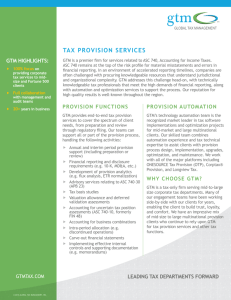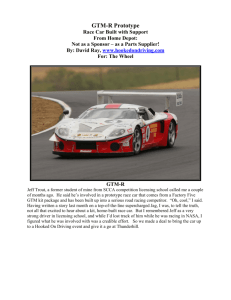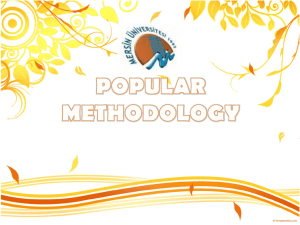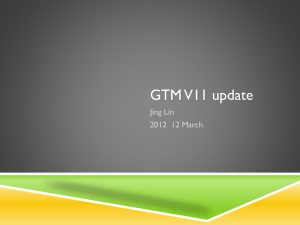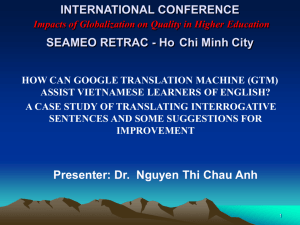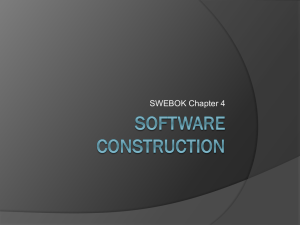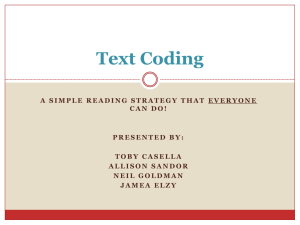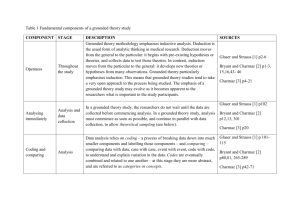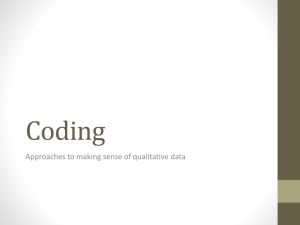Thur pm Grounded Theory
advertisement
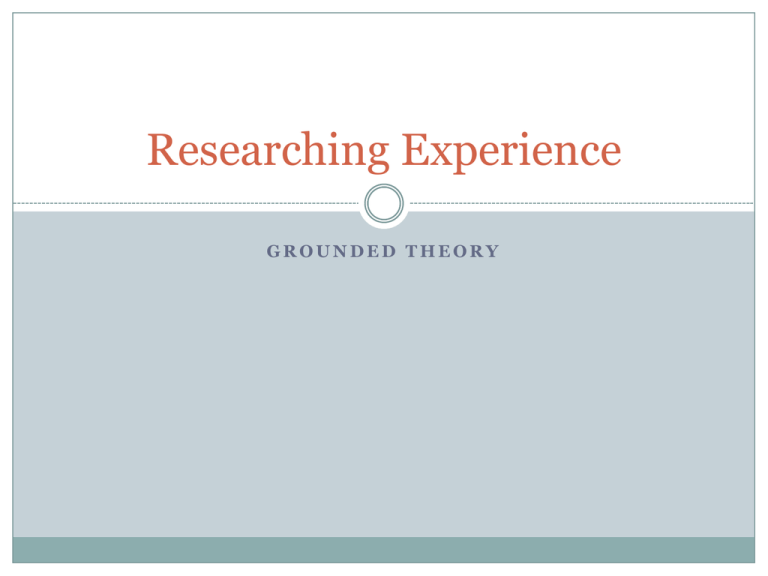
Researching Experience GROUNDED THEORY Choosing GTM 2 Research Q: Charmaz (1995) GTM are useful when researching ‘individual processes, interpersonal relations and the reciprocal effects between individual and larger social processes’. She further notes that GTM are ‘useful for studying typical social psychological topics such as motivation, personal experience, emotions, identity, attraction, prejudice and interpersonal cooperation and conflict Congruence between the philosophy of contructivist GTM and personal positionality Titscher et al. (2000) 1991 – 1998 GTM received almost 64% of all types of method, quantitative as well as qualitative, citations in the Social Science Citation Index GTM 3 GTM involves a systematic, inductive and comparative approach for conducting research. Charmaz (2003): noted GT ‘in some cases refers, correctly, to the result of the research process, i.e. a grounded theory, but in many other cases it refers to the method used in the research process. 4 The aim is to develop a well grounded theory that describes, explains, interprets phenomenon of interest. and predicts the In 2006, Charmaz summarised GTM as follows: ‘GT involves taking comparisons from data and reaching up to construct abstractions and then down to tie these abstractions to data. It means learning about the specific and the general – and seeing what is new in them – then exploring their links to larger issues or creating larger unrecognised issues in entirety’. GTM 5 What is integral to GTM? Bryant & Charmaz (2007) refer to GTM as ‘a family of methods’ Hood (2007): ‘troublesome trinity’ theoretical sampling, constant comparison of data to theoretical categories and focus on the development of theory via theoretical saturation of categories 6 Ultimately as noted by Charmaz (1995) the purpose of GTM is ‘to develop a theoretical analysis of the data that has relevance to the area of study’ (p.48). She notes the following six characteristics of GTM: 1. 2. 3. 4. 5. 6. simultaneous dynamic data collection and analysis creation of analytic codes and categories developed from data not from preconceived hypotheses development of mid range theories to explain processes and behaviour memo writing of personal process in the development of analytic codes and detailing categories, the crucial intermediate step between coding data and draft writing theoretical sampling that is sampling not for representativeness of a given population but for building theory and refining and checking the researchers emerging conceptual categories delaying the literature review 7 GTM aims at making meaning explicit To do this and to build rather than test theory, data is coded Coding: Tool for handling masses of data Enables consideration of alternate meanings Ensures systematic work Supports creative work Identifies, develops & relates categories that are the building blocks of theory Defines what data are about. Process with number of levels: initial line by line coding focused coding categories Line by line coding 8 Examining each line of data or unit of meaning and naming, defining, or labelling actions or events that occur in it or that are represented by it using short, active, specific terms Nb to ask questions of the data to identify actions and significant processes e.g. What do the statements take for granted? What process is at issue here? How does this process develop? How and when does the process change? Critical analysis in coding process helps anchor and embed the analyst in the data and supports against ‘flights of fancy’ Focus Coding 9 Focus coding uses the most significant or frequent initial codes to: Sort Synthesise Explain Organise larger amounts of data This stage of coding is more directed, selective and conceptual than line by line coding and represents what the analyst suggests explain most accurately, the recurring concepts that are beginning to emerge from the data. Focus Coding 10 During focused coding the analyst evaluates and clarifies the categories and the relationships between them Where possible it is important to use the participants’ words though as coding progresses it will engage more abstraction Movement across interviews and observations and comparisons of participants’ experiences, actions and processes to form categories from significant codes Reflexivity 11 Reflexivity: salient process in GTM Coding is supported through reflexive process whereby informal notes about the analytical process are kept Observations about the data, questions about connections between codes, personal commentary about possibilities emerging in the data needs to be recorded memo writing, journalling field notes Reflexivity clarifies: ‘the researcher’s experience, decisions, and interpretations in ways that bring the researcher into the process and allow the reader to assess how and to what extent the researcher’s interests, positions and assumptions influenced inquiry’ (Charmaz, 2006). It moves to illuminate ‘how the researcher conducts his or her research, relates to the research participants and represents them in written reports’ (Charmaz, 2006). Internal supervisor Constant Comparison & Categories 12 Categories emerge through a process of ‘constant comparison’ Wasserman (2009): ‘everything is compared with everything and all of the time. Statements within an interview are compared with each other and with other interviews, new data are compared with older data, conceptual categories derived from some data are compared with other data directly and with the conceptual categories derived from that data’ Glaser & Strauss (1967) constant comparative method is an aid to the analyst in theory generation in terms of: integration, consistency, plausibility and remaining close to the data Keeping memos at this stage helps analyst tease out categories and build links between emergent concepts thereby advancing theory development through the process. Theoretical Sampling & Saturation 13 Theoretical Sampling As noted by Glaser and Strauss (1967) initial decisions regarding data collection are based on general area or subject matter but as theory begins to develop data collection becomes more focused and driven by the emerging theory. This process is known as theoretical sampling and entails an iterative process for the analyst of collecting and analyzing data and deciding what data to collect next and where to find them, in order to develop the emergent theory. The cyclical process of data collection and analysis and collection is repeated until there is no new emergent conceptual information, a point known as ‘saturation’ Triangulation 14 An important part of data collection is triangulation which is a process whereby the research issue being explored is considered through multiple perspectives of different stakeholders. Triangulation process as noted by Stake (2005): ‘considered a process of using multiple perceptions to clarify meaning verifying the repeatability of an observation or interpretation’ (p.454). Finally...... 15 Data should be written up using thick description (Geertz, 1973) with sources being frequently quoted verbatim to allow the reader to gain a full understanding of categories developed. One works towards establishing four criteria of the methodology as identified by Rennie and Brewer (1987) those of : developing believable research that is seen as plausible by the reader comprehensive research in that it accounts for most of the data grounded research that is tied to the data applicable research that should lead to additional investigation

